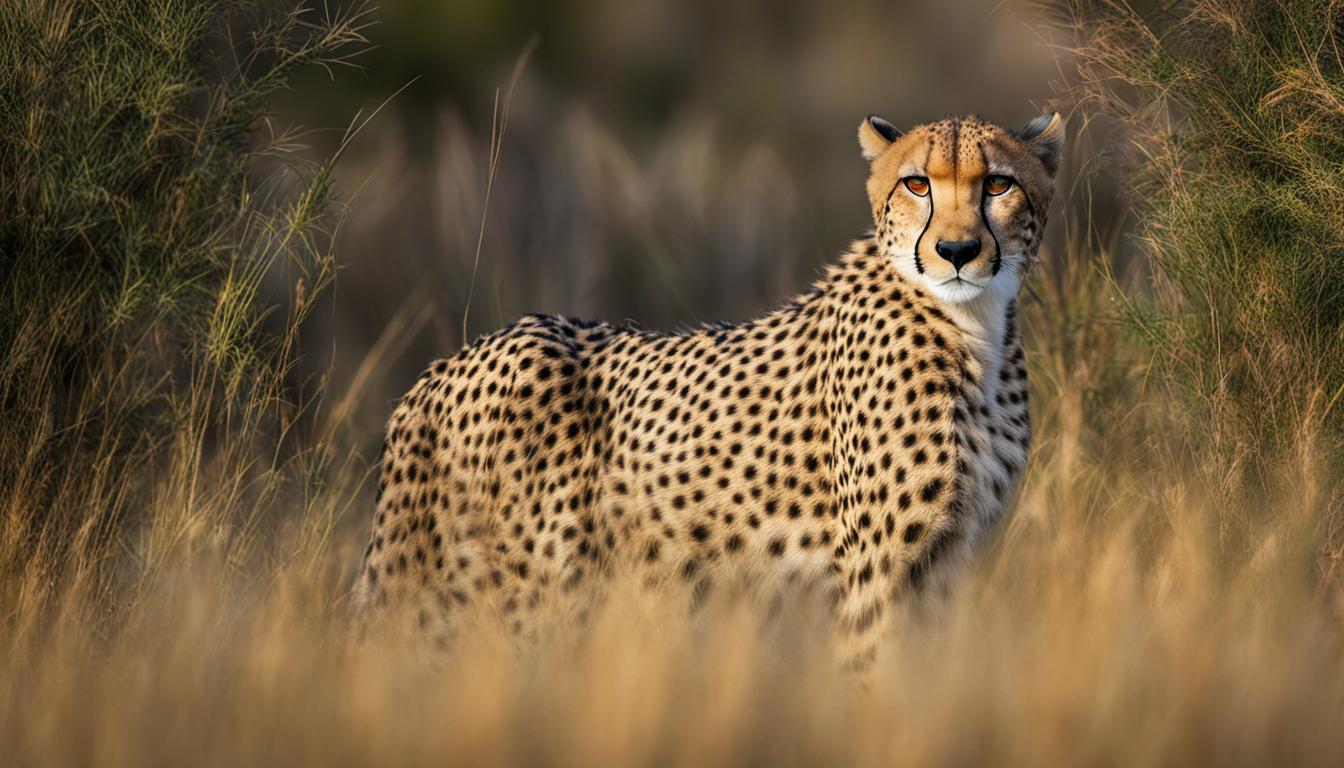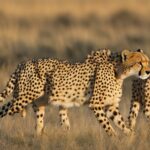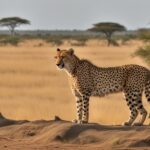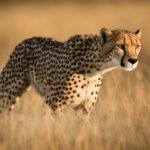When it comes to hunting, cheetahs have a secret weapon that sets them apart from other predators – their exceptional vision. Cheetahs rely on their powerful sight to track down their prey efficiently, making them one of the most successful hunters in the animal kingdom.
Cheetahs have the ability to spot prey from up to 5 kilometers away, thanks to their wide field of view. With a visual range of 210 degrees, compared to humans’ 140 degrees, cheetahs can scan their surroundings with ease, never missing a potential target.
But it’s not just their field of view that gives cheetahs the advantage. Their retina is also adapted for hunting, with elongated visual streaks that enhance their ability to scan the horizon and detect movement. Cheetahs also have more cone photoreceptor cells in their retina, particularly S cones that enhance color discrimination, allowing them to spot prey even in open grassland environments.
To protect their eyes and maintain focus during high-speed chases, cheetahs have unique tear marks, or malar stripes, that redirect sunlight away from their eyes. This enables them to keep their eyes on the prize and make precise turns and maneuvers while in pursuit of their prey.
In conclusion, a cheetah’s vision is a vital tool in their hunting strategies. Their exceptional eyesight, combined with their unique anatomical adaptations, allows them to spot prey from long distances and make successful high-speed chases. So the next time you marvel at a cheetah’s incredible hunting skills, remember that it all starts with their extraordinary vision.
The physiology of cheetah vision
Cheetahs possess remarkable physiological adaptations that contribute to their exceptional vision, enabling them to excel in their hunting endeavors. One of these adaptations is their increased number of cone photoreceptor cells in the retina, particularly S cones that enhance color vision. This allows cheetahs to discriminate colors effectively in their open grassland habitats, where prey blends with the surrounding environment.
Another unique feature of cheetah vision is their tear marks, also known as malar stripes. These dark lines redirect sunlight away from their eyes, reducing glare and improving their focus during high-speed chases. By minimizing the impact of harsh sunlight, cheetahs can maintain visual acuity and track their prey with precision, even at incredible speeds.
“The vision of a cheetah is finely tuned for its hunting lifestyle. The elongated visual streaks, increased cone photoreceptor cells, and tear marks all contribute to their ability to spot, track, and capture prey effectively.”
Furthermore, the cheetah’s visual system is optimized for daytime hunting. With a wide field of view of around 210 degrees, cheetahs can scan their surroundings extensively, detecting even the slightest movement. Their elongated visual streaks enhance their ability to scan the horizon and effectively spot potential prey from a distance.
In conclusion, the physiology of cheetah vision is a testament to their remarkable adaptation for hunting. Their increased cone photoreceptor cells, tear marks, wide field of view, and elongated visual streaks all contribute to their exceptional eyesight. These adaptations enable cheetahs to successfully spot, track, and capture their prey, showcasing their incredible hunting prowess.
The physiology of cheetah vision
Cheetah Hunting Strategies
Cheetahs employ a range of hunting strategies to capture their prey and ensure a successful kill. These strategies are carefully crafted to take advantage of their exceptional speed, agility, and keen eyesight. The combination of these skills allows cheetahs to excel as efficient and effective hunters in their natural habitats.
One of the primary techniques employed by cheetahs is stalking. They use their exceptional eyesight to stay hidden and observe their surroundings, carefully selecting their target. Cheetahs rely on their keen vision to track the movements of their prey, evaluating the optimal moment to strike. Once the moment is right, cheetahs initiate a high-speed chase, utilizing their incredible speed and agility to close the gap between themselves and their prey in a matter of seconds.
During the chase, cheetahs maintain a fixed gaze on their target, thanks to their specially adapted inner ear structures. This allows them to make precise turns and maneuvers while maintaining focus on their prey. The cheetah’s ability to maintain visual contact with their target during high-speed pursuits is a crucial factor in their hunting success. It enables them to adjust their trajectory and plan their attack, increasing the likelihood of a successful kill.
Once within striking distance, cheetahs use their powerful hind legs and sharp, retractable claws to bring down their prey. These physical adaptations, combined with their quick reflexes and lightning-fast acceleration, allow cheetahs to deliver a swift and fatal blow. The entire hunting process, from stalking to the final pounce, is a testament to the cheetah’s remarkable hunting strategies and their ability to adapt and thrive in their environment.
Hunting Strategies Summary:
- Stalking: Cheetahs use their exceptional eyesight to remain hidden and observe their surroundings, selecting the optimal moment to strike.
- High-speed chase: Cheetahs initiate a rapid pursuit, utilizing their incredible speed and agility to close the gap between themselves and their prey.
- Maintaining focus: Specially adapted inner ear structures allow cheetahs to maintain visual contact with their target during high-speed pursuits, enabling precise turns and attack planning.
- Swift takedown: Cheetahs use their powerful hind legs and retractable claws to deliver a swift and fatal blow to their prey.
The hunting strategies employed by cheetahs are a remarkable testament to their evolutionary adaptations and their ability to survive and thrive in their natural habitats. Understanding these strategies provides insights into the behavior and unique hunting techniques of these awe-inspiring creatures.

Cheetah Habitat and Conservation
Cheetahs are primarily found in open grassland and savanna habitats. These habitats provide the perfect environment for cheetahs to hunt efficiently, with their wide-open spaces allowing for high-speed chases. However, the cheetah’s habitat is under threat from human occupation and development. The encroachment of thorn bush into open grasslands limits the cheetah’s ability to hunt effectively and find suitable prey. This loss of habitat not only affects the cheetah population but also threatens other species that rely on open grasslands for survival.
Conservation efforts are crucial for the protection and preservation of cheetahs and their habitats. One key aspect of cheetah conservation is the restoration of open habitats. This involves removing thorn bush and promoting sustainable land management practices to ensure the availability of suitable hunting grounds for cheetahs. By creating and maintaining open grasslands, we can support the survival of not only cheetahs but also other wildlife species that depend on these habitats.
The Impact of Bush Encroachment
Bush encroachment is a significant threat to cheetah habitats. It occurs when dense vegetation, such as thorn bush, expands into grasslands, reducing available hunting grounds and disrupting the natural balance of the ecosystem. This encroachment limits the visibility and mobility of cheetahs, making hunting more challenging and reducing their hunting success rate. It also affects the population dynamics of prey species, as the dense vegetation provides cover for predators, making it difficult for prey animals to detect and evade them.
To combat bush encroachment and protect cheetah habitats, conservation organizations and local communities work together to implement strategies such as bush control and habitat restoration. These efforts involve the removal of invasive plant species, reestablishing native grasses, and implementing sustainable land management practices. By addressing bush encroachment, we can help create a healthier and more sustainable ecosystem for cheetahs and other wildlife.
| Threats to Cheetah Habitat | Conservation Efforts |
|---|---|
| Bush encroachment | Removal of invasive plant species |
| Human occupation and development | Sustainable land management practices |
| Loss of open grasslands | Habitat restoration efforts |
Protecting and preserving cheetah habitats is crucial for the long-term survival of these magnificent creatures. Through ongoing conservation efforts, we can ensure that future generations have the opportunity to witness the speed and grace of the world’s fastest land animal.

Cheetah Behavior and Social Structure
Cheetahs exhibit unique behavior and have a fascinating social structure. Let’s explore how these incredible animals behave and interact with each other.
Female Cheetahs
Female cheetahs are primarily solitary animals, living and hunting on their own. They have large home ranges and often follow migratory prey herds. This allows them to maximize their chances of finding food and ensure their survival. Female cheetahs are also known for their exceptional skills in raising their cubs. They teach their offspring essential hunting techniques and provide them with the necessary tools for survival in the wild.
Cheetah Social Structure
Male cheetahs, on the other hand, form small coalitions with their littermates. These coalitions consist of two to four males and offer various advantages, such as increased protection and improved hunting success. Male cheetahs establish territories, often in open grassland areas, where they are likely to find potential mates. Within these territories, they patrol and mark their boundaries, ensuring that other males understand that the area is already occupied.
Cheetahs have a unique mating system that allows females to mate with multiple partners. As a result, cubs from the same litter can have different fathers. This provides genetic diversity within the population and helps maintain healthy populations of cheetahs. After raising their cubs for approximately a year and a half, female cheetahs leave them, and the littermates stick together for an additional six months before eventually going their separate ways.
Summary
Cheetah behavior is shaped by their solitary nature, with female cheetahs living on their own and males forming coalitions. Female cheetahs are skilled mothers, raising their cubs and teaching them how to survive in the wild. Male cheetahs form small groups to increase their chances of survival and successfully compete for mates. This unique social structure adds to the astonishing nature of these majestic creatures.
Conclusion:
The vision of cheetahs plays a crucial role in their hunting strategies. Their exceptional eyesight enables them to spot and track prey from long distances, while their unique anatomical adaptations allow them to maintain focus during high-speed chases. Cheetahs rely on their powerful sight to navigate the open grassland and savanna habitats they inhabit.
However, the survival of cheetahs is under threat due to habitat loss, human-wildlife conflict, and illegal hunting. Encroachment of thorn bush into their habitats limits their ability to hunt effectively, affecting not only cheetah populations but also other species that rely on open grasslands. Conservation efforts are crucial in protecting cheetahs and their habitats.
Efforts focused on restoring open habitats, such as the removal of thorn bush and the promotion of sustainable land management practices, are essential for the continued existence of these remarkable animals. By supporting cheetah conservation, you can contribute to the preservation of not only their unique hunting strategies but also the overall health of the ecosystem they inhabit.
How does a cheetah’s vision help it hunt for prey and avoid threats in the wild?
A cheetah’s vision is its greatest asset in hunting for prey and avoiding primary threats to leopards in the wild. With specialized eyes that provide exceptional depth perception and acute focus, cheetahs can spot subtle movements from great distances, making them efficient and successful hunters in their natural habitat.
Do Cheetahs Rely More on Vision or Other Senses When Hunting at Night?
Cheetahs hunting at night rely heavily on their exceptional vision to spot prey in the darkness. Their keen eyesight allows them to track movements from great distances, giving them a significant advantage in the hunt. While their other senses play a role, their vision is paramount in the nighttime pursuit of prey.
FAQ
What role does vision play in cheetah hunting strategies?
Vision plays a crucial role in cheetah hunting strategies. Cheetahs rely on their exceptional eyesight to spot and track prey from long distances, allowing them to effectively stalk and chase their targets.
What adaptations does the cheetah’s visual system have?
The cheetah’s visual system has several adaptations. They have a higher number of cone photoreceptor cells in their retina, particularly S cones that enhance color vision. They also have tear marks, or malar stripes, that redirect sunlight away from their eyes, reducing glare and improving their focus during high-speed chases.
What are some cheetah hunting strategies?
Cheetahs employ various hunting strategies. They begin by stalking their prey, utilizing their exceptional eyesight to stay hidden and observe their surroundings. When the moment is right, they initiate a high-speed chase, reaching speeds of up to 70 miles per hour in short bursts. Once within striking distance, cheetahs use their powerful hind legs and sharp retractable claws to bring down their prey.
What threatens the cheetah’s habitat?
The cheetah’s habitat is under threat from factors such as human occupation, development, and the encroachment of thorn bush into open grasslands. These factors limit the cheetah’s ability to hunt effectively and impact not only the cheetah population but also other species that rely on open grasslands.
What is the social structure of cheetahs?
Cheetahs are primarily solitary animals, with female cheetahs living on their own and males forming small coalitions with littermates. Female cheetahs have large home ranges and typically follow migratory prey herds. Female cheetahs raise their cubs alone for about a year and a half, teaching them essential hunting skills before the littermates go their separate ways.
How can cheetah conservation efforts contribute to their survival?
Conservation efforts focused on restoring open habitats and promoting sustainable land management practices can help protect cheetah populations and their habitats. By addressing habitat loss and minimizing human-wildlife conflict, we can ensure the continued existence of these remarkable animals.










